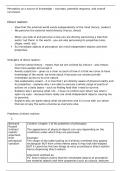Summary
Summary - epistemology - perception as a source of knowledge (7172)
- Course
- Institution
A summary sheet of all year 1 epistemology perception as a source of knowledge. covering topics of direct and indirect realism and idealism. in this sheet it contains the strengths and weaknesses of each theory, possible responses and overall judgement. it provides a framework to aid in answering b...
[Show more]



